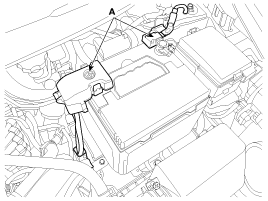 Kia Rio: Battery Sensor: Description
Kia Rio: Battery Sensor: Description
Vehicles have many control units that use more electricity. These units
control their own system based on information from diverse sensors. It is important
to have a stable power supply as there diverse sensors giving a variety of information.
Battery sensor (A) is mounted on battery (-) terminal. It transmits battery
voltage, current, temperature information to ECM. ECM controls generating voltage
by duty cycle based on these signals.

When battery sensor signal fault occurs, inspect the vehicle parasitic
draw in advance after inspecting the sensor because the sensor will
behave abnormally when the parasitic draw is more than 100mA. (Refer
to vehicle parasitic current inspection)
It takes a few hours for a new battery sensor to detect the battery
state correctly.
Perform the following process after replacing the battery sensor.
| 1.
Ignition switch ON/OFF.
|
| 2.
Park the vehicle about 4 hours.
|
| 3.
After 4 hours later, check that the SOC (State of charge)
of battery is displayed on GDS properly.
|
| 4.
After engine start ON/OFF 2 times or more, check the SOF
(State of function) of battery using GDS.
|
For the vehicle equipped with a battery sensor, be careful not
to damage the battery sensor when the battery is replaced or recharged.
| •
When replacing the battery, it should be same one (type,
capacity and brand) that is originally installed on your vehicle.
If a battery of a different type is replaced, the battery sensor
may recognize the battery to be abnormal.
|
| •
When installing the ground cable on the negative post
of battery, tighten the clamp with specified torque of 4.0 ~
6.0 N.m (0.4 ~ 0.6 kgf.m, 3.0 ~ 4.4 lb-ft). An excessive tightening
torque can damage the PCB internal circuit and the battery terminal.
|
| •
When recharging the battery, ground the negative terminal
of the booster battery to the vehicle body.
|
| -
Refer to DTC manual code “U1111, U1112” to inspect the
battery sensor.
|
| -
Must replace the engine wiring assembly to replace the
battery sensor. Battery sensor doesn’t be replaced as a part
only.
|
1. Battery sensor
2. Brake Booster Vacuum Pressure Sensor (BBVPS)
3. AGM battery
4. DC/ DC Converter (LDC)
5. ISG OFF Switch
6. Alternator
7. Starter
8. Brake s ...
In order to ensure adequate brake power assistance in every situation,
the brake booster is equipped with a partial vacuum sensor. The brake booster
vacuum pressure sensor is located beside t ...
See also:
Automatic transaxle
Automatic transaxle operation
The automatic transaxle has 6 forward speeds and one reverse speed. The individual
speeds are selected automatically, depending on the position of the shift lever.
&# ...
General Troubleshooting Information
Before Troubleshooting
1.
Check applicable fuses in the appropriate fuse/relay box.
2.
Check the battery for damage, state of charge, and cl ...
Defroster
CAUTION - Conductors
To prevent damage to the conductors bonded to the inside surface of the rear
window, never use sharp instruments or window cleaners containing abrasives to clean
the window. ...
 Kia Rio: Battery Sensor: Description
Kia Rio: Battery Sensor: Description




 Components Location
Components Location Brake Booster Vacuum Pressure Sensor: Description
Brake Booster Vacuum Pressure Sensor: Description